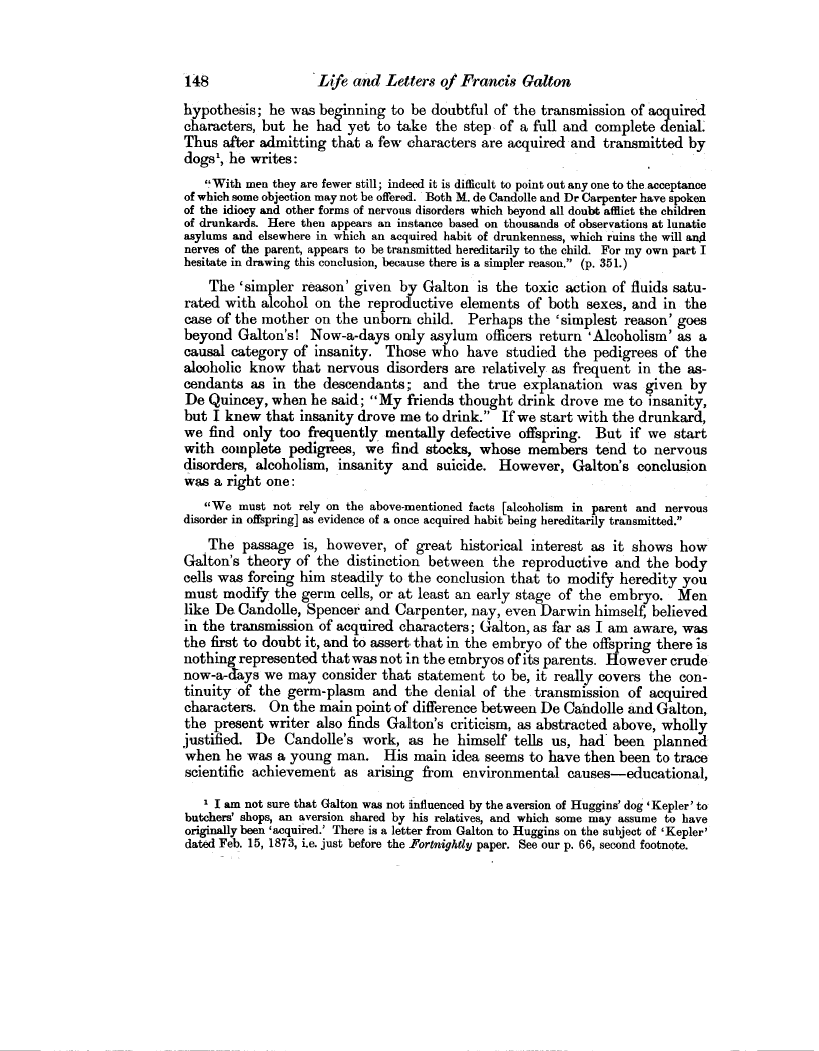148 Life and Letters of Francis Galton
hypothesis; he was beginning to be doubtful of the transmission of acquired characters, but he had yet to take the step, of a full and complete denial. Thus after admitting that a few characters are acquired and transmitted by dogs', he writes
"With men they are fewer still; indeed it is difficult to point out any one to the-acceptance of which some objection may not be offered. Both M. de Candolle and Dr Carpenter have spoken of the idiocy and other forms of nervous disorders which beyond all doubt afflict the children of drunkards. Here then appears an instance based on thousands of observations at lunatic asylums and elsewhere in which an acquired habit of drunkenness, which ruins the will ansi nerves of the parent, appears to be transmitted hereditarily to the child. For my own part I hesitate in drawing this conclusion, because there is a simpler reason." (p. 351.)
The `simpler reason' given by Galton is the toxic action of fluids saturated with alcohol on the reproductive elements of both sexes, and in the case of the mother on the unborn child. Perhaps the `simplest reason' goes beyond Galton's! Now-a-days only asylum officers return `Alcoholism' as a causal category of insanity. Those who have studied the pedigrees of the alcoholic know that nervous disorders are relatively as frequent in the ascendants as in the descendants; and the true explanation was given by De Quincey, when he said; "My friends thought drink drove me to insanity, but I knew that insanity drove me to drink." If we start with the drunkard, we find only too frequently mentally defective offspring. But if we start with complete pedigrees, we find stocks, whose members tend to nervous disorders, alcoholism, insanity and suicide. However, Galton's conclusion was a right one
"We must not rely on the above-mentioned facts [alcoholism in parent and nervous disorder in offspring] as evidence of a once acquired habit being hereditarily transmitted."
The passage is, however, of great historical interest as it shows how Galton's theory of the distinction between the reproductive and the body cells was forcing him steadily to the conclusion that to modify heredity you must modify the germ cells, or at least an early stage of the embryo. Men like De. Candolle, Spencer and Carpenter, nay, even Darwin himself, believed in the transmission of acquired characters; Galton, as far as I am aware, was the first to doubt it, and to assert that in the embryo of the offspring there is nothing represented that was not in the embryos of its parents. However crude now-a-days we may consider that statement to be, it really covers the continuity of the germ-plasm and the denial of the transmission of acquired characters. On the main point of difference between De Candolle and Galton, the present writer also finds Galton's criticism, as abstracted above, wholly justified. De Candolle's work, as he himself tells us, had' been planned when he was a young man. His main idea seems to have then been to trace scientific achievement as arising from environmental causes-educational,
1 I am not sure that Galton was not influenced by the aversion of Huggins' dog ' Kepler' to butchers' shops, an aversion shared by his relatives, and which some may assume to have originally been 'acquired.' There is a letter from Galton to Huggins on the subject of 'Kepler' dated Feb. 15, 1873, i.e. just before the Fortnightly paper. See our p. 66, second footnote.

